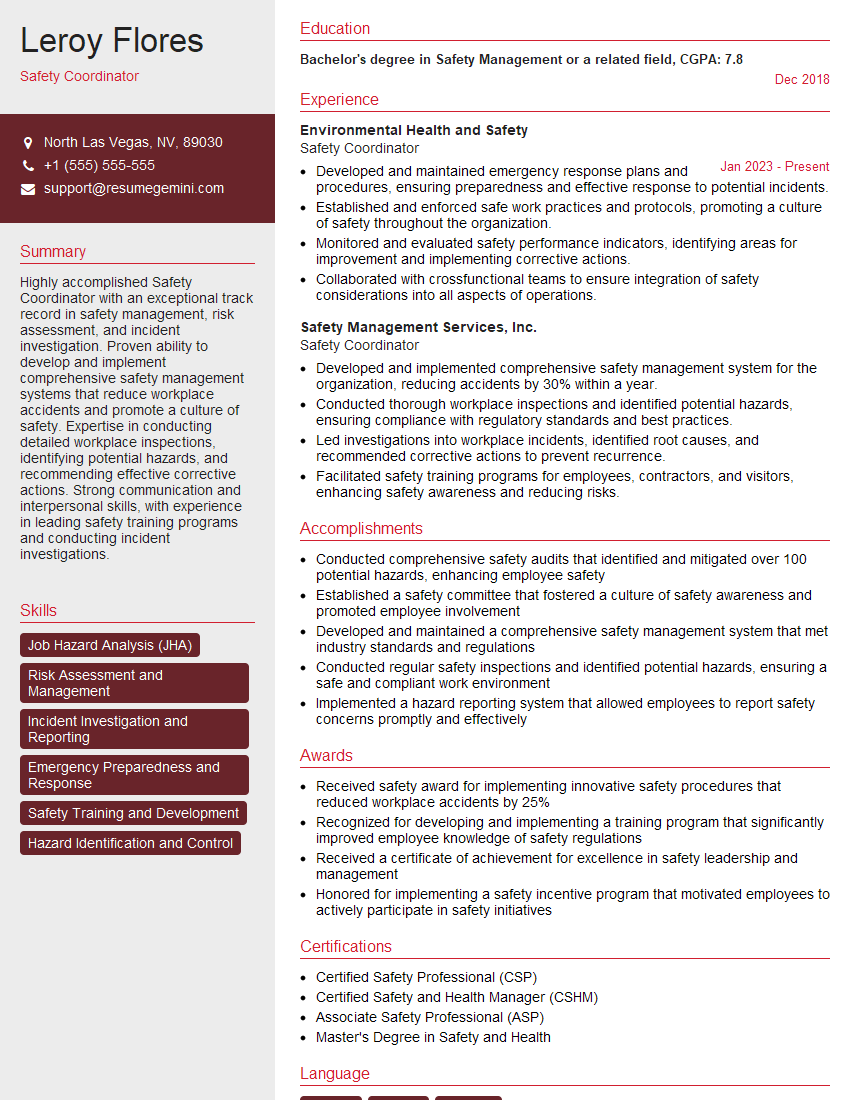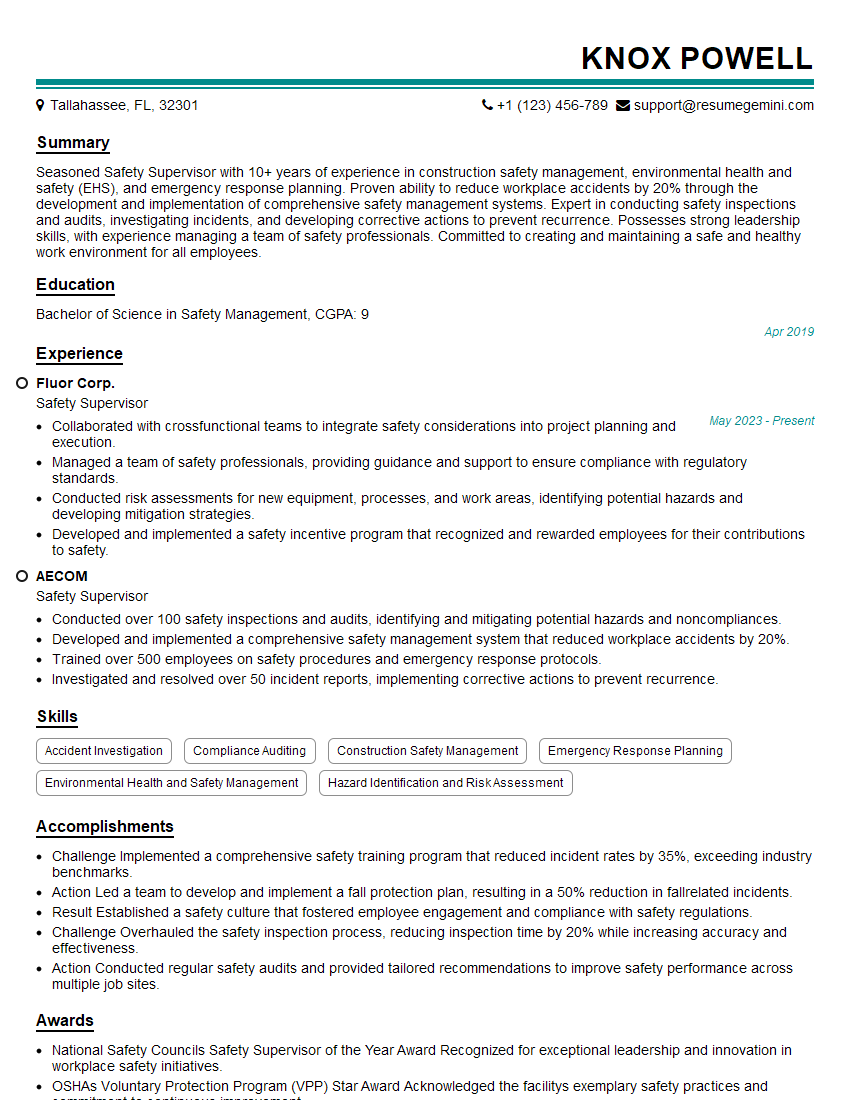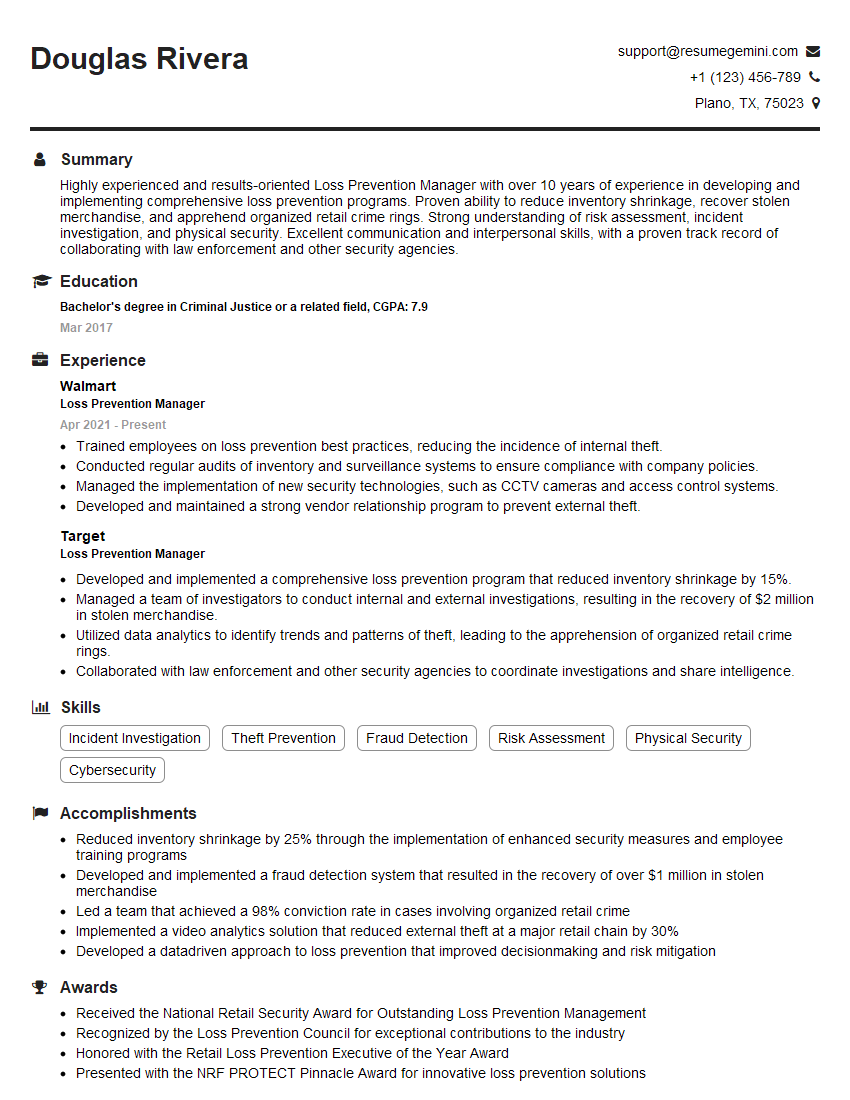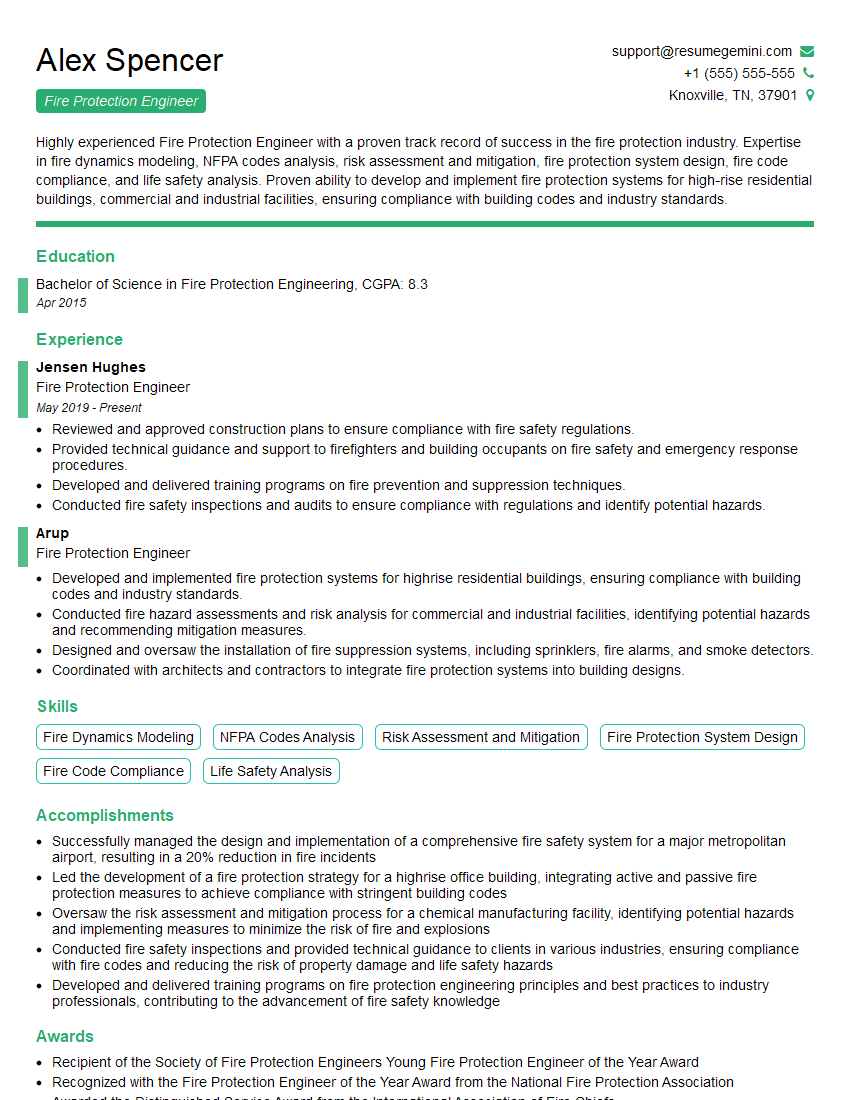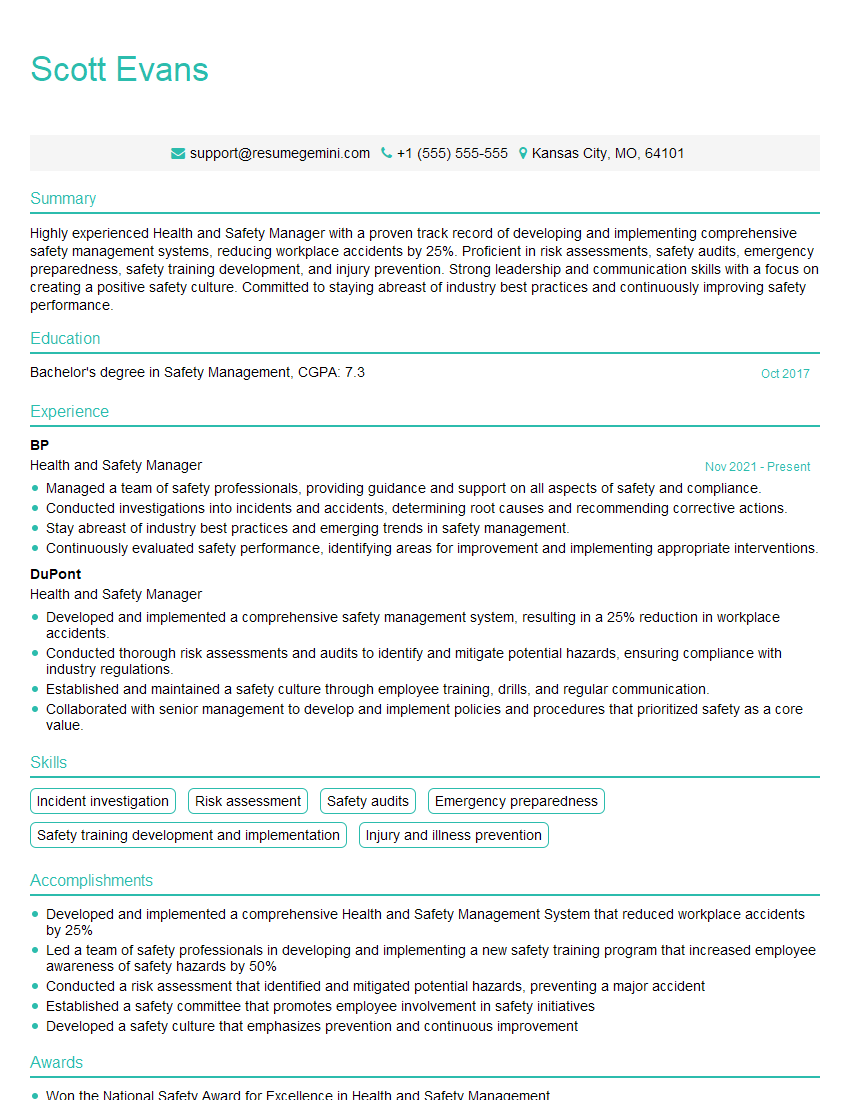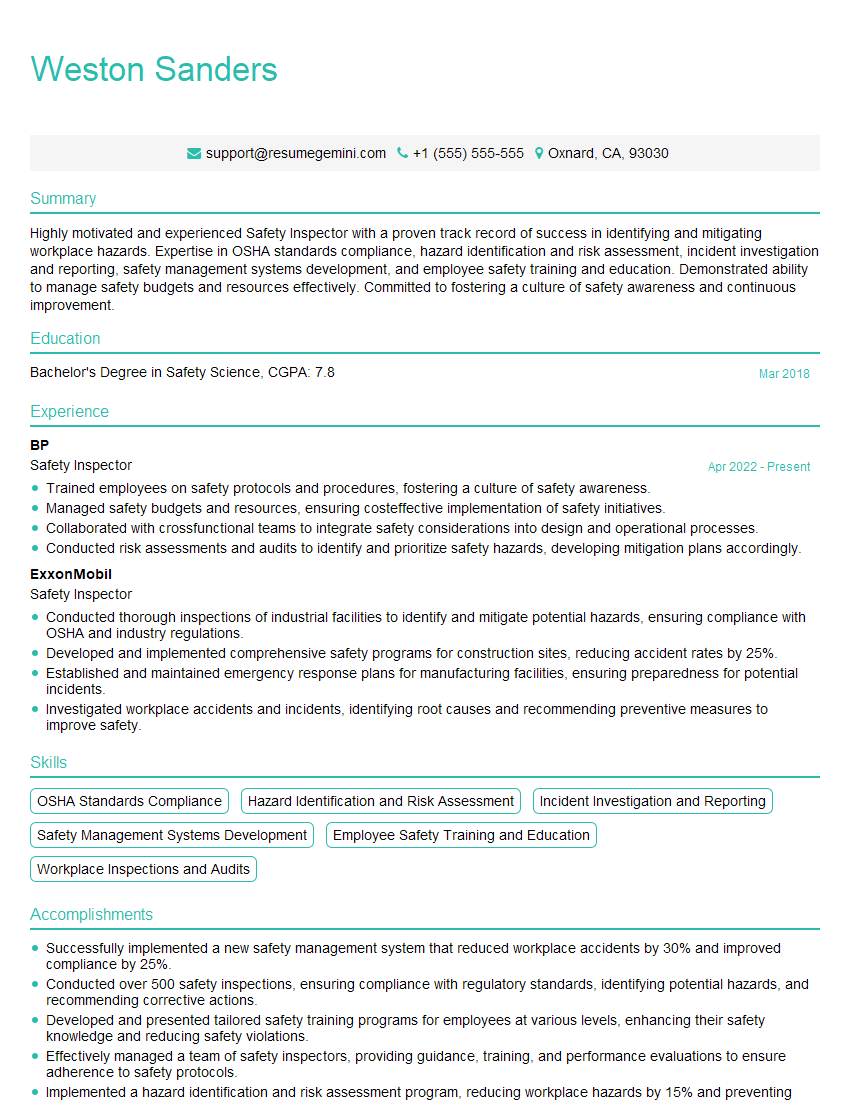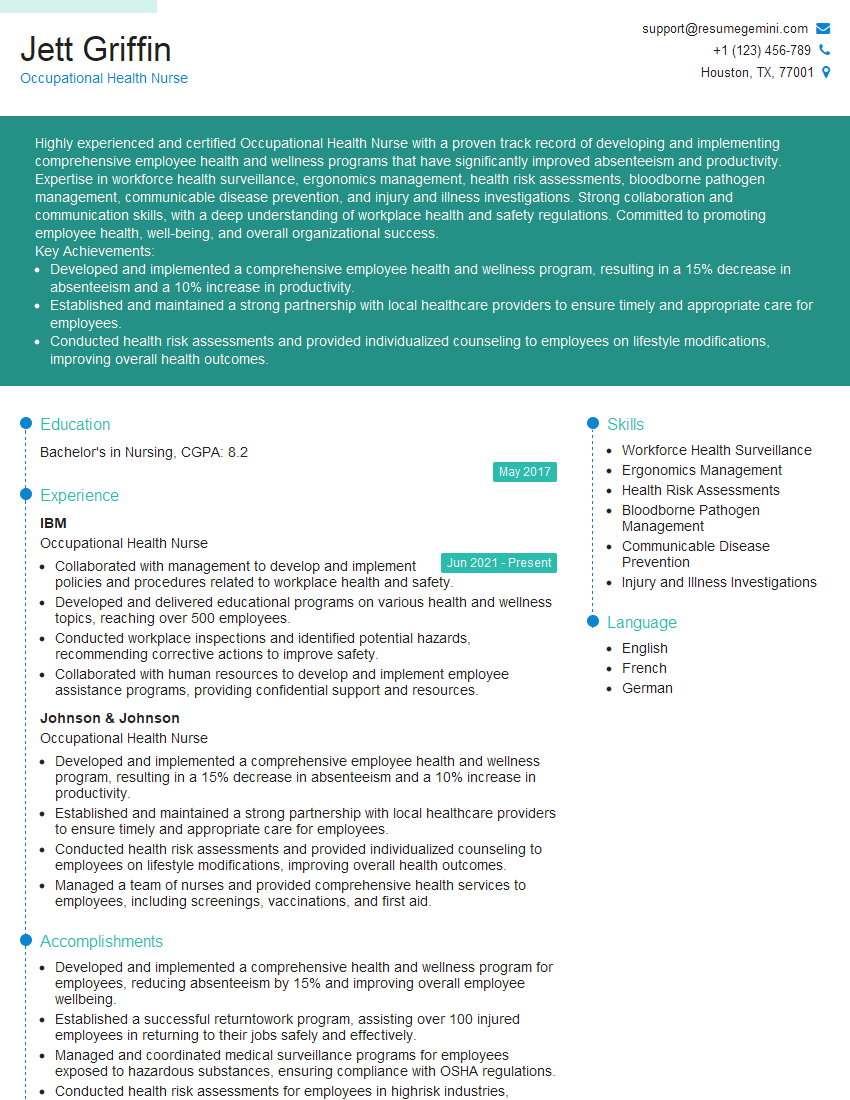Feeling uncertain about what to expect in your upcoming interview? We’ve got you covered! This blog highlights the most important Shipyard Safety Practices interview questions and provides actionable advice to help you stand out as the ideal candidate. Let’s pave the way for your success.
Questions Asked in Shipyard Safety Practices Interview
Q 1. Describe your experience with implementing and maintaining a Shipyard Safety Management System (SMS).
Implementing and maintaining a Shipyard Safety Management System (SMS) is crucial for minimizing risks and ensuring a safe working environment. My experience involves a multi-faceted approach, starting with the development of a comprehensive SMS manual aligned with industry best practices like the ISM Code (International Safety Management Code). This manual outlines procedures, responsibilities, and emergency response plans. I’ve been involved in every stage, from initial risk assessments and hazard identification to the implementation of control measures and regular audits.
For example, in a previous role, I spearheaded the implementation of a new SMS for a large shipyard. This involved training all personnel on new procedures, updating safety signage, and introducing a robust reporting system for near misses and accidents. We also integrated technology, using digital platforms for documentation, training records, and incident reporting, improving efficiency and transparency. Regular internal audits, coupled with external verification audits, ensured continuous improvement and compliance with relevant regulations.
Maintaining an effective SMS requires ongoing effort. This includes regular reviews of procedures, adapting to changes in technology and regulations, and continuous training and education for employees. I’ve found that fostering a strong safety culture, where every employee feels empowered to report hazards and contribute to safety improvements, is paramount to the success of any SMS.
Q 2. What are the key elements of a comprehensive risk assessment in a shipyard environment?
A comprehensive risk assessment in a shipyard is a systematic process to identify potential hazards and evaluate the risks associated with them. It’s not a one-time event but an ongoing process. Key elements include:
- Hazard Identification: This involves a thorough walkthrough of the shipyard, identifying potential hazards from various sources – machinery, materials, working at heights, confined spaces, electrical hazards, etc. Techniques like checklists, job safety analyses (JSAs), and hazard and operability studies (HAZOP) are invaluable here.
- Risk Evaluation: Once hazards are identified, their likelihood and severity are assessed. This often uses a risk matrix, considering factors like the frequency of exposure, potential consequences (injury, environmental damage, property loss), and the control measures in place.
- Risk Control: This involves implementing control measures to mitigate identified risks. This could range from engineering controls (e.g., guarding machinery) to administrative controls (e.g., safe work procedures) and personal protective equipment (PPE).
- Documentation and Communication: The entire risk assessment process must be thoroughly documented, including identified hazards, risk levels, control measures implemented, and responsibilities assigned. Clear communication of findings and risk control measures to all relevant personnel is critical.
- Monitoring and Review: The risk assessment is not a static document. It needs regular review and updates based on any changes in work practices, equipment, regulations, or accident investigations.
For instance, when assessing the risk of working at heights during the construction of a ship, we would consider the height of the fall, the presence of safety nets, the use of harnesses, the wind conditions, and the training of personnel. This holistic approach is critical for effective risk management.
Q 3. How would you handle a hazardous material spill incident?
Handling a hazardous material spill requires a rapid and coordinated response, prioritizing the safety of personnel and the environment. My approach follows a structured procedure:
- Immediate Actions: Isolate the spill area. Evacuate personnel from the immediate vicinity. Alert emergency services and relevant authorities (depending on the type and quantity of the spilled material).
- Containment: Use appropriate containment methods like absorbent pads, booms, or dams to prevent the spread of the spill. This step is crucial in minimizing the impact of the hazard.
- Cleanup: Employ appropriate personal protective equipment (PPE) and follow specific cleanup procedures outlined in the Safety Data Sheet (SDS) for the hazardous material. Specialized cleanup crews might be required depending on the material.
- Disposal: Dispose of contaminated materials and cleanup waste according to regulations and relevant waste management protocols.
- Investigation and Reporting: A thorough investigation of the incident should be carried out to determine the cause of the spill and to identify any shortcomings in existing safety procedures. A detailed report is crucial for preventing similar incidents in the future. This report needs to be documented and shared with relevant authorities.
For example, if a spill of lubricating oil occurs, we would immediately cordon off the area, use absorbent pads to soak up the oil, and ensure proper disposal according to local regulations. The investigation would focus on identifying the source of the leak and implementing preventive measures like regular equipment inspections.
Q 4. Explain your understanding of Permit-to-Work systems.
A Permit-to-Work (PTW) system is a formal, documented procedure used to control potentially hazardous work activities. It ensures that necessary precautions are taken before work commences in hazardous areas. It’s a critical tool for preventing accidents in high-risk environments like shipyards.
The system involves a series of steps:
- Application: A worker applies for a permit, detailing the work to be performed, the potential hazards involved, and the proposed control measures.
- Issuance: A competent person (authorized by management) reviews the application and issues the permit if the proposed control measures are deemed adequate. This often includes inspections of the work area.
- Execution: Work is carried out strictly according to the conditions specified in the permit.
- Completion: Upon completion of the work, the permit is closed out, and a final inspection is conducted to ensure the area is safe.
- Cancellation: Permits can be canceled at any time if unsafe conditions arise.
A PTW system might be used for hot work (welding, cutting), confined space entry, working at heights, or any other high-risk activities. For example, before starting welding on a ship’s hull, a PTW would specify the location, the fire prevention measures in place (fire watch, fire extinguishers), and the appropriate PPE.
Q 5. Describe your experience with Job Safety Analysis (JSA) and Job Hazard Analysis (JHA).
Both Job Safety Analysis (JSA) and Job Hazard Analysis (JHA) are systematic methods for identifying hazards and developing safe work procedures. While often used interchangeably, subtle differences exist.
Job Safety Analysis (JSA) is a more detailed and comprehensive approach that breaks down a job into sequential steps, identifying potential hazards at each step, and recommending control measures. It usually includes a thorough evaluation of potential risks and the development of specific precautions.
Job Hazard Analysis (JHA) focuses primarily on identifying potential hazards associated with a specific job or task. It is often less detailed than a JSA and may not include the same level of sequential breakdown. However, both aim to minimize workplace risks.
In my experience, I’ve used both extensively. For instance, when preparing for a major overhaul of a ship’s engine, we’d conduct a thorough JSA, detailing every step from isolation of power sources to the handling of heavy components, identifying potential hazards like crushing injuries, falls, and exposure to hazardous chemicals. This would result in a very detailed procedure with specific risk mitigations.
For a simpler task, like changing a light bulb in a high-bay area, a JHA might suffice, identifying the risk of falls and outlining the use of proper equipment and safety harnesses.
Q 6. What are the common hazards associated with shipyard work?
Shipyard work presents a wide range of hazards. These can be broadly categorized as:
- Falling Objects: Dropped tools, materials, or equipment from heights pose a significant risk.
- Working at Heights: Working on scaffolding, ladders, or at high elevations increases the risk of falls.
- Confined Spaces: Entering tanks, holds, or other confined spaces exposes workers to oxygen deficiency, toxic gases, and other hazards.
- Machinery Hazards: Rotating parts, pinching points, and moving equipment pose risks of crushing, entanglement, and other injuries.
- Electrical Hazards: Contact with live wires or equipment can cause serious electrical shocks or burns.
- Hazardous Materials: Exposure to paints, solvents, welding fumes, and other hazardous materials can cause respiratory problems, skin irritation, and other health issues.
- Noise Hazards: High noise levels from machinery can cause hearing loss.
- Fire and Explosion Hazards: The presence of flammable materials and welding activities increases the risk of fires and explosions.
- Ergonomic Hazards: Repetitive tasks, awkward postures, and heavy lifting can lead to musculoskeletal injuries.
It is vital to understand and implement specific control measures to mitigate these hazards, making the shipyard a safer working environment.
Q 7. How do you ensure compliance with OSHA regulations (or equivalent international standards)?
Ensuring compliance with OSHA regulations (or equivalent international standards) requires a multi-pronged approach. It’s not just about following the rules but about embedding safety into the company culture.
- Regular Training: Providing comprehensive safety training to all employees is paramount. This includes hazard awareness, safe work procedures, and emergency response protocols.
- Inspections and Audits: Regular workplace inspections and safety audits are crucial to identify potential hazards and non-compliance issues. This includes regular checks of safety equipment and PPE.
- Record Keeping: Meticulous record-keeping is essential. This includes documenting training records, accident investigations, safety inspections, and hazard identifications.
- Incident Reporting and Investigation: A robust system for reporting and investigating incidents is critical to learn from mistakes and prevent future occurrences. Near misses should be reported and investigated as thoroughly as accidents.
- Staying Updated: Regulations and best practices evolve. Staying current with the latest updates and incorporating them into safety procedures is essential.
- Proactive Safety Culture: Fostering a proactive safety culture where employees feel empowered to report hazards and contribute to safety improvements is just as critical as following regulations.
For instance, we regularly conduct mock drills and safety training exercises, simulating various scenarios, including fire emergencies, hazardous material spills, and evacuation procedures. This ensures that the response to real incidents is well-rehearsed and effective.
Q 8. Explain your familiarity with PPE (Personal Protective Equipment) and its appropriate use.
Personal Protective Equipment (PPE) is crucial for shipyard safety. It’s the last line of defense against hazards, protecting workers from injuries. My familiarity encompasses a wide range of PPE, including:
- Head Protection: Hard hats to protect against falling objects.
- Eye and Face Protection: Safety glasses, goggles, and face shields to prevent eye injuries from flying debris or chemicals.
- Respiratory Protection: Respirators to filter out harmful dust, fumes, gases, or vapors, especially essential in confined spaces or when working with hazardous materials.
- Hearing Protection: Earplugs or muffs to protect against noise-induced hearing loss from loud machinery.
- Hand Protection: Gloves to protect against cuts, abrasions, chemicals, and extreme temperatures. Different gloves are needed for different tasks.
- Foot Protection: Steel-toe boots to protect against crushing injuries from falling objects or heavy equipment.
- Body Protection: High-visibility clothing, flame-resistant clothing, and protective suits depending on the task and environment.
Appropriate PPE use involves selecting the correct equipment for the specific hazard, ensuring it fits properly, inspecting it for damage before each use, and knowing how to properly don and doff it. For instance, a welder needs a specific welding helmet with the appropriate shade filter, while someone working with chemicals requires gloves and a respirator compatible with the specific chemical. Regular training and proper supervision are key to ensuring correct PPE usage.
Q 9. What are your strategies for promoting a strong safety culture within a shipyard?
Building a strong safety culture in a shipyard is a continuous process that begins with leadership commitment and extends to every worker. My strategies include:
- Leadership Visibility: Management actively participating in safety initiatives, leading by example, and demonstrating a genuine commitment to worker safety.
- Open Communication: Creating channels for workers to voice safety concerns without fear of retribution. This includes regular safety meetings, suggestion boxes, and open-door policies.
- Proactive Hazard Identification: Implementing regular safety inspections, job hazard analyses (JHAs), and risk assessments to identify and address potential hazards before incidents occur.
- Effective Training: Providing comprehensive and engaging safety training tailored to specific job roles and hazards. This goes beyond lectures, using simulations, practical demonstrations, and interactive exercises.
- Incentivization and Recognition: Rewarding safe work practices and recognizing individuals and teams who contribute to a safe work environment. This can include awards, certificates, or public acknowledgment.
- Incident Investigation and Root Cause Analysis: Thoroughly investigating every incident, no matter how minor, to understand the root causes and implement preventative measures. This is critical for learning and preventing future occurrences.
- Data-Driven Approach: Tracking safety metrics, analyzing trends, and identifying areas needing improvement. This allows for targeted interventions and continuous improvement.
A strong safety culture isn’t just about rules; it’s about creating a shared understanding and commitment to safety where everyone takes personal responsibility for their safety and the safety of their colleagues. Think of it like a team sport – everyone needs to play their part for success.
Q 10. Describe your experience with incident investigation and root cause analysis.
My experience in incident investigation and root cause analysis follows a systematic approach. It begins with securing the scene, gathering evidence, and interviewing witnesses. I utilize techniques such as the ‘5 Whys’ to drill down to the root causes, going beyond immediate causes to uncover underlying systemic issues. For example, if a worker fell from a scaffold (initial incident), the ‘5 Whys’ might reveal:
- Why did the worker fall? The scaffold guardrail was missing.
- Why was the guardrail missing? It was damaged and not reported.
- Why wasn’t it reported? Workers felt pressured to maintain productivity and feared reporting issues.
- Why was there pressure to maintain productivity? Unrealistic deadlines and insufficient staffing levels.
- Why were deadlines unrealistic and staffing insufficient? Poor project management and inadequate planning.
This reveals the root cause lies not in the immediate failure of the guardrail, but in systemic issues of project management and communication. This informs corrective actions that address the systemic problems, rather than just fixing the immediate symptoms.
My reports document the findings, root causes, corrective actions, and preventative measures. This information is shared with relevant personnel and used for safety training and improving safety procedures.
Q 11. How do you conduct safety training for shipyard workers?
Safety training for shipyard workers is crucial and must be tailored to the specific hazards of each role. My approach involves a blend of methods:
- Classroom Training: Lectures and presentations to provide theoretical knowledge on safety regulations, hazard identification, and risk assessment.
- Hands-on Training: Practical demonstrations and exercises, such as proper use of PPE, operation of equipment, and emergency response procedures.
- Simulations and Role-Playing: Simulating real-world scenarios, such as emergency evacuations or responding to hazardous material spills, to enhance practical skills and improve decision-making under pressure.
- On-the-Job Training (OJT): Experienced workers mentoring and supervising new hires, guiding them on safe work practices specific to their tasks.
- Interactive Training Modules: Utilizing online modules, videos, and interactive games to make training more engaging and accessible.
- Regular Refresher Training: Periodic retraining to reinforce key safety concepts and address changes in procedures or regulations.
I believe in making training engaging and relevant. Using real-life examples, case studies, and interactive activities makes the information stick and motivates workers to take safety seriously.
Q 12. What are your methods for identifying and mitigating potential hazards?
Identifying and mitigating potential hazards in a shipyard requires a proactive approach. My methods include:
- Job Hazard Analysis (JHA): Systematically examining each job task to identify potential hazards and control measures. This is done before a job starts to prevent accidents.
- Regular Safety Inspections: Conducting frequent inspections of the shipyard to identify potential hazards, such as damaged equipment, unsafe working conditions, or potential hazards from weather conditions.
- Risk Assessments: Evaluating the likelihood and severity of identified hazards and implementing appropriate control measures to reduce the risk. This includes both qualitative and quantitative risk assessment techniques.
- Near Miss Reporting System: Encouraging workers to report near misses – incidents that could have resulted in an injury but didn’t – to learn from potential hazards and prevent future accidents.
- Safety Audits: Regularly conducting comprehensive audits to evaluate the effectiveness of safety programs and identify areas for improvement.
Mitigation strategies depend on the nature of the hazard. They can range from engineering controls (e.g., guarding machinery), administrative controls (e.g., work permits), to PPE (as discussed earlier). The hierarchy of controls – elimination, substitution, engineering controls, administrative controls, and PPE – guides the selection of the most effective control measures.
Q 13. Explain your understanding of emergency response procedures in a shipyard setting.
Emergency response procedures in a shipyard must be well-defined, regularly practiced, and readily accessible to all workers. My understanding encompasses:
- Emergency Action Plan (EAP): A comprehensive plan outlining procedures for various emergencies, such as fires, explosions, medical emergencies, and hazardous material spills.
- Emergency Response Teams: Trained personnel responsible for handling specific emergencies, such as firefighting teams, medical teams, and spill response teams.
- Emergency Communication System: Clear communication channels to alert workers of emergencies and coordinate response efforts, including alarms, public address systems, and two-way radios.
- Emergency Equipment and Supplies: Adequate fire extinguishers, first-aid kits, spill kits, and other necessary equipment readily accessible throughout the shipyard.
- Emergency Drills and Training: Regular drills and training exercises to familiarize workers with emergency procedures and ensure the effectiveness of the EAP.
- Evacuation Routes and Assembly Points: Clearly marked evacuation routes and designated assembly points for workers to gather after evacuation.
A successful emergency response relies on clear communication, well-trained personnel, and readily available equipment. Regular drills and training build confidence and ensure that workers know what to do in case of an emergency.
Q 14. How do you ensure effective communication of safety information to workers?
Effective communication of safety information is critical for a safe shipyard. My approach uses multiple channels to ensure the message reaches everyone:
- Safety Meetings: Regular meetings to discuss safety issues, updates, and relevant information.
- Toolbox Talks: Short, informal discussions at the start of work shifts to address specific safety concerns or review critical procedures.
- Safety Newsletters and Bulletins: Communicating safety news, updates, and best practices through written materials.
- Visual Communication: Using signs, posters, and other visual aids to convey safety messages clearly and concisely.
- Digital Communication: Leveraging email, intranet, and mobile apps to share information quickly and efficiently.
- Training Programs: Incorporating safety information into training programs to reinforce key concepts and practices.
- Feedback Mechanisms: Establishing systems for workers to provide feedback and report safety concerns.
The key is to use multiple channels and tailor the communication method to the audience and the information being shared. Simple, clear language and visuals are crucial for ensuring everyone understands the message. The ultimate goal is to create a culture of open communication where safety concerns are addressed promptly and effectively.
Q 15. Describe your experience with conducting safety audits and inspections.
Conducting safety audits and inspections is crucial for proactively identifying and mitigating hazards in a shipyard environment. My approach involves a multi-stage process. First, I develop a detailed checklist based on relevant regulations, industry best practices, and site-specific risk assessments. This checklist covers areas such as personal protective equipment (PPE) usage, machinery guarding, emergency procedures, and housekeeping.
Second, I conduct a thorough visual inspection of the work areas, paying close attention to potential hazards like exposed wiring, unstable scaffolding, or improperly stored materials. During the inspection, I interact with workers, observing their work practices and asking questions to gauge their understanding of safety procedures. Third, I document all findings, including photographs and detailed descriptions of any non-compliances or potential hazards. Finally, I prepare a comprehensive report summarizing the findings, outlining corrective actions, and assigning responsibilities and deadlines for remediation.
For example, during a recent audit, I discovered a lack of proper fall protection measures on a high-rise structure. My report detailed the deficiency, recommended installing guardrails and safety nets, and assigned the responsibility to the project supervisor with a deadline for completion. This proactive approach prevented a potential accident.
Career Expert Tips:
- Ace those interviews! Prepare effectively by reviewing the Top 50 Most Common Interview Questions on ResumeGemini.
- Navigate your job search with confidence! Explore a wide range of Career Tips on ResumeGemini. Learn about common challenges and recommendations to overcome them.
- Craft the perfect resume! Master the Art of Resume Writing with ResumeGemini’s guide. Showcase your unique qualifications and achievements effectively.
- Don’t miss out on holiday savings! Build your dream resume with ResumeGemini’s ATS optimized templates.
Q 16. What is your approach to managing safety concerns raised by workers?
Managing safety concerns raised by workers is paramount to fostering a safe and productive work environment. My approach is built on open communication, prompt investigation, and effective remediation. When a worker raises a concern, I listen attentively, ensuring they feel heard and respected. I then thoroughly investigate the concern, gathering information from various sources, including the worker, supervisors, and relevant documentation. This might involve reviewing risk assessments, inspecting the work area, or interviewing other employees.
Based on the investigation findings, I determine the appropriate action. This could range from immediate corrective action, such as removing a hazard, to implementing new safety procedures or providing additional training. I always keep the worker updated on the progress and ensure the issue is resolved efficiently and effectively. For example, a welder once expressed concern about the adequacy of ventilation in his work area. After investigation, I arranged for enhanced ventilation, ensuring a safer working environment.
Q 17. How familiar are you with confined space entry procedures?
I am extremely familiar with confined space entry procedures. These procedures are critical for preventing fatalities and injuries in potentially hazardous environments like tanks, vessels, and pipelines. A confined space is defined as an enclosed or partially enclosed space with limited access and egress, and which may present hazards such as oxygen deficiency, toxic atmospheres, or engulfment hazards.
My understanding encompasses all aspects of confined space entry, including:
- Permit-required confined space entry program: This includes detailed procedures for testing the atmosphere, ventilation, and ensuring proper personal protective equipment (PPE) is used.
- Atmospheric monitoring: Before entry, the atmosphere must be tested for oxygen levels, flammability, and toxic gases using calibrated instruments.
- Emergency response planning: Having a detailed rescue plan and trained personnel is crucial in case of an emergency.
- Communication systems: Maintaining constant communication between the entrant, attendant, and external support is vital.
- Rescue equipment and procedures: Appropriate rescue equipment, such as harnesses, ropes, and breathing apparatus, must be available.
I have extensive experience in implementing and overseeing these procedures, ensuring compliance with all applicable regulations and industry best practices.
Q 18. Explain your understanding of fall protection measures in shipyard construction.
Fall protection is absolutely critical in shipyard construction, where workers often operate at significant heights. My understanding of fall protection measures includes the hierarchy of controls, starting with elimination of the hazard (if feasible), then engineering controls (e.g., guardrails), followed by administrative controls (e.g., training and supervision), and finally, personal protective equipment (PPE) as the last line of defense.
Common fall protection measures in shipyard construction include:
- Guardrails: Providing a physical barrier to prevent falls from elevated work surfaces.
- Safety nets: Nets installed below work areas to catch falling workers.
- Personal fall arrest systems (PFAS): Harnesses, lanyards, and anchorage points to arrest a fall.
- Fall restraint systems: Systems that prevent a worker from reaching a fall hazard.
- Scaffolding safety: Ensuring scaffolding is properly erected, inspected, and maintained.
I have significant experience in selecting, installing, and inspecting fall protection systems to ensure they are compliant with relevant regulations and provide adequate protection for workers.
Q 19. What are your strategies for managing contractor safety on a shipyard site?
Managing contractor safety on a shipyard site is crucial because contractors often work alongside shipyard employees, potentially increasing the risk of accidents. My strategy for managing contractor safety is proactive and encompasses several key elements. Before commencing work, I ensure all contractors have a comprehensive safety plan that aligns with the shipyard’s safety policies. This plan must detail their safety procedures, emergency response plans, and the specific measures they will implement to mitigate the risks associated with their work.
I conduct thorough pre-work safety meetings with contractors to clarify safety expectations and address any questions or concerns. Regular site inspections are carried out to monitor the contractors’ adherence to safety rules and regulations. Contractors are held accountable for any safety violations, and corrective actions are implemented immediately. For example, if a contractor is found to be using outdated or faulty equipment, they are required to replace it immediately. Open communication and regular feedback sessions are essential to ensure that any safety concerns are promptly addressed.
Q 20. Describe your experience with using safety software or databases.
I have experience using various safety software and databases, including incident reporting systems, risk assessment software, and training management systems. These tools are invaluable for managing and tracking safety performance. For example, I’ve used software to track incident reports, identify trends, and generate reports to highlight areas needing improvement. Risk assessment software helps me systematically identify and evaluate hazards, prioritize risk mitigation strategies, and document findings.
Training management systems allow me to efficiently track employee training records, ensuring everyone receives necessary safety training and their certifications are up-to-date. The use of these systems allows for more effective data analysis and informed decision-making in improving safety performance. The data collected provides valuable insight into the effectiveness of safety programs and enables us to proactively address potential risks.
Q 21. How do you ensure that safety regulations are applied consistently?
Ensuring consistent application of safety regulations requires a multifaceted approach. First, clear and concise safety policies and procedures, aligned with relevant regulations and best practices, must be established and disseminated to all employees and contractors. Regular training programs are essential to ensure everyone understands their responsibilities and the proper procedures to follow. This training should include both theoretical knowledge and hands-on practical exercises.
Second, robust safety oversight is critical. This involves regular safety inspections, audits, and monitoring of work practices. Non-compliance must be addressed promptly and decisively, with consistent application of corrective actions. Third, a strong safety culture needs to be fostered. This involves promoting open communication, rewarding safe behavior, and providing a safe environment where employees feel empowered to report hazards and concerns without fear of retribution. By combining clear policies, effective training, consistent enforcement, and a positive safety culture, we can ensure the consistent application of safety regulations.
Q 22. How do you handle conflicting priorities between safety and productivity?
The perceived conflict between safety and productivity is a false dichotomy. In reality, a strong safety culture increases productivity. Accidents lead to delays, lost time, increased costs (medical, legal, insurance), and decreased morale. My approach involves proactively integrating safety into every aspect of the project, not treating it as an afterthought.
Instead of viewing safety as a constraint, I frame it as a competitive advantage. We use techniques like Job Safety Analysis (JSA) to identify potential hazards before work begins, allowing us to develop safer, more efficient work processes. For example, if a task requires working at heights, we wouldn’t just mandate harnesses; we’d analyze the entire process to see if scaffolding or a different approach could eliminate the need for working at heights entirely. This results in fewer delays due to accidents and injuries, leading to improved productivity.
Open communication is crucial. I work collaboratively with project managers and foremen to clearly communicate safety expectations and integrate them into project timelines and budgets. Transparency ensures everyone understands the rationale behind safety measures and their contribution to overall success.
Q 23. How do you measure the effectiveness of your safety programs?
Measuring the effectiveness of safety programs requires a multi-faceted approach, going beyond simply tracking the number of accidents. Key metrics include:
- Incident Rate (TRIR/LTIR): Total Recordable Incident Rate (TRIR) and Lost Time Incident Rate (LTIR) measure the frequency and severity of accidents. Lower rates indicate better safety performance.
- Near Miss Reporting: Encouraging reporting of near misses allows us to identify potential hazards before they lead to accidents. A high rate of near miss reports, combined with corrective actions, is a positive indicator.
- Safety Observation Scores: Regular safety observations help identify unsafe behaviors or conditions. Improved scores show increased adherence to safety protocols.
- Employee Satisfaction Surveys: These gauge employee perceptions of safety culture, training effectiveness, and management commitment to safety.
- Training Completion Rates: High completion rates indicate employees are actively engaged in improving their safety knowledge and skills.
These metrics are regularly reviewed and analyzed to identify areas for improvement. Trends are tracked over time to evaluate the effectiveness of implemented safety initiatives. For instance, a significant drop in TRIR following the introduction of a new safety training program demonstrates its effectiveness.
Q 24. Describe your experience with developing and implementing safety policies.
I have extensive experience in developing and implementing safety policies, starting with a thorough risk assessment of the shipyard environment. This involves identifying potential hazards, assessing their risks, and determining appropriate control measures. For example, in one project, we identified a high risk of crane accidents. The subsequent policy included stricter crane operation protocols, increased operator training, and routine crane inspections.
Policy development involves collaboration with stakeholders – workers, supervisors, safety officers, and management. This ensures the policies are practical, enforceable, and accepted by all. Policies must be clear, concise, and easily accessible to all employees. I use plain language and visuals to facilitate understanding. Regular reviews and updates ensure policies remain relevant and effective.
Implementing policies requires strong communication and training. We conduct regular safety meetings, toolbox talks, and hands-on training to reinforce the policies and best practices. We also use signage, posters, and other visual aids to promote safety awareness throughout the shipyard. Effective implementation also includes regular audits and inspections to ensure compliance and identify any areas needing improvement.
Q 25. What are the common types of injuries in shipyard environments and how can they be prevented?
Shipyard environments present a unique array of hazards, leading to various injuries. Common types include:
- Falls: From heights, on uneven surfaces, or into open hatches. Prevention includes proper fall protection systems, improved lighting, and regular inspections of working surfaces.
- Struck-by injuries: From falling objects, swinging loads, or moving equipment. Prevention includes using hard hats, implementing safe lifting practices, and establishing designated work zones.
- Caught-in/between injuries: From machinery, equipment, or materials. Lockout/Tagout procedures, guarding equipment, and proper use of personal protective equipment (PPE) are crucial.
- Crush injuries: Caused by heavy equipment or materials. Proper lifting techniques, machinery guards, and adequate space for maneuverability are critical.
- Cuts and lacerations: From sharp tools, materials, or equipment. Using appropriate PPE (e.g., gloves, safety glasses), regular tool maintenance, and safe handling practices minimize risks.
Prevention strategies encompass a multi-layered approach, integrating engineering controls (e.g., guarding machinery), administrative controls (e.g., work permits), and personal protective equipment (PPE). Comprehensive training, regular inspections, and a strong safety culture are also essential for reducing the incidence of these injuries.
Q 26. Explain your understanding of the role of safety committees and worker participation.
Safety committees and worker participation are vital components of a robust safety program. Safety committees, ideally comprising representatives from all levels of the organization, including workers, supervisors, and management, provide a forum for identifying hazards, developing solutions, and monitoring the effectiveness of safety initiatives.
Workers’ direct involvement is invaluable. They have firsthand experience with the day-to-day hazards and can offer valuable insights into potential risks and practical solutions. Their participation fosters a culture of shared responsibility for safety, leading to increased compliance and a greater sense of ownership.
Effective worker participation is achieved through various means: regular safety meetings, safety suggestion boxes, near miss reporting systems, and open communication channels. Management must actively listen to and act upon worker concerns and suggestions. For instance, worker feedback about a poorly designed workstation could lead to ergonomic improvements, preventing musculoskeletal injuries.
Q 27. How do you stay up-to-date with changes in shipyard safety regulations and best practices?
Staying abreast of changes in shipyard safety regulations and best practices requires a proactive and multifaceted approach. This includes:
- Subscribing to industry publications: Staying informed about the latest research, standards, and best practices.
- Attending industry conferences and workshops: Networking with peers and learning about emerging trends and innovations in safety.
- Monitoring regulatory updates: Following changes in OSHA (Occupational Safety and Health Administration) regulations and other relevant agencies.
- Participating in professional organizations: Engaging with industry experts and benefiting from shared knowledge and experiences.
- Utilizing online resources: Accessing safety databases, training materials, and industry guidelines online.
By actively seeking out and engaging with this information, I ensure that our safety policies and practices are aligned with the most current standards and best practices, maintaining a leading-edge safety culture within the shipyard.
Q 28. Describe a situation where you had to make a difficult decision related to shipyard safety.
In a previous project, we were under pressure to meet a tight deadline. A subcontractor proposed a shortcut that would save time but potentially compromise safety. The shortcut involved using a less robust lifting method for a heavy component. While this would accelerate the project, it increased the risk of a serious accident.
My decision was to reject the shortcut and insist on the originally planned, safer method. This meant a delay in the project schedule, requiring me to explain the situation to upper management and address concerns about the timeline. I presented a thorough risk assessment detailing the potential consequences of the shortcut, emphasizing the long-term costs of an accident versus the short-term gain of a faster, but riskier, approach.
Ultimately, management supported my decision, recognizing the paramount importance of safety. While there was a minor delay, we avoided a potential catastrophic accident. This reinforced the critical message that prioritizing safety, even with tight deadlines, is essential for long-term project success and a safe working environment for everyone.
Key Topics to Learn for Shipyard Safety Practices Interview
- Personal Protective Equipment (PPE): Understanding the types of PPE required in various shipyard environments (e.g., hard hats, safety glasses, high-visibility clothing, respirators), their proper use, limitations, and maintenance.
- Hazard Identification and Risk Assessment: Practical application of risk assessment methodologies (e.g., HAZOP, What-If analysis) to identify potential hazards in shipyard operations, evaluate their risks, and implement control measures.
- Fall Protection: Knowledge of fall protection systems (e.g., harnesses, lifelines, fall arrestors), their proper selection and use, and relevant regulations and standards.
- Confined Space Entry Procedures: Understanding the procedures and precautions necessary for safe entry and work within confined spaces, including atmospheric monitoring, ventilation, and rescue plans.
- Emergency Response and Procedures: Familiarity with emergency response plans, including fire prevention and suppression, first aid, evacuation procedures, and communication protocols.
- Working at Heights: Practical knowledge of safe working practices at heights, including scaffolding, ladders, and other elevated work platforms.
- Electrical Safety: Understanding the potential hazards of working with electricity in a shipyard environment, including lockout/tagout procedures and safe work practices.
- Crane and Lifting Operations: Knowledge of safe lifting practices, including load calculations, crane signals, and load securing techniques.
- Material Handling Safety: Understanding safe methods for handling various materials, including proper lifting techniques, use of material handling equipment, and storage practices.
- Hot Work Permits and Procedures: Knowledge of procedures for obtaining and utilizing hot work permits, including fire watch requirements and safety precautions.
Next Steps
Mastering Shipyard Safety Practices is crucial for a successful and safe career in this demanding industry. Demonstrating a strong understanding of these principles during your interview will significantly enhance your job prospects. To further strengthen your application, focus on creating an ATS-friendly resume that highlights your skills and experience effectively. ResumeGemini is a trusted resource that can help you build a professional and impactful resume. Examples of resumes tailored to Shipyard Safety Practices are available to guide you through this process.
Explore more articles
Users Rating of Our Blogs
Share Your Experience
We value your feedback! Please rate our content and share your thoughts (optional).
What Readers Say About Our Blog
good
